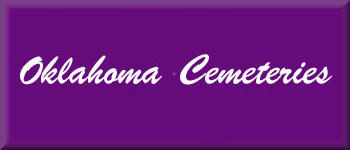


 |
 |  |
HISTORY OF NEW ZION CEMETERY Submitted by : Vernon Leake © The Carney Citizen dated Sep 16 1937
Submitted by: Vernon Leake HISTORY OF NEW ZION CEMETERY
New Zion work is nearing completion. Construction work on the walls of the chapel being constructed at New Zion is about completed and work soon will start on the roof and finishing the inside.The building is being constructed to take the place of the old log church that was constructed at the opening of the Sac and Fox country to settlement.The building is being constructed of native stone and the dedicatory service will soon be held as soon as it is ready for use.Religion is universal. Wherever man has gone, it has been the custom through the ages for him to set up some sort of religious worship. Often missionaries are sent into a country before it is legally open to settlement. As soon as a settlement has been made, it is but natural for man to seek some place to worship. The church is a community institution.As surely as the night follows the day, churches are institutions of worship,and follow the establishment of any settlement in a new country.Long before white man could become legal residents of Oklahoma and Indian territories, missionaries were sent into this country to work among the Indians.The Sac and Fox Indians were given a reservation in what is now Lincoln County in the early 1870's. These were followed by the Kickapoos and the Shawnee and Pottawatomies.The opening to settlement to Lincoln and Pottawatomie counties did not take place for more than two years after the opening of the original Oklahoma territory to white settlement. All of that country lying west of Oklahoma and Logan counties was still known as "Indian country."It was not until a few days before the proclamation was issued by the president that it was known that Lincoln and Pottawatomie counties would be open to settlement by white men.Like the opening of the original Oklahoma territory, this was to be settled by a "run." People gathered at the borders of the new country and in every way possible get to the places on which they hoped to live and make a home. The opening of these counties was made September 22, 1891."Ashes to ashes and dust to dust", is the scriptural admonition given to us all. It was one of the characteristic differences between the beasts of the field and that of man that man has always has taken some sort of care of the dead. Some historians even have gone so far as to say that the degree of civilization attained by a nation can be determined by the method and manner of taking care of the dead.So, in the opening of a new country one of the first necessities is the proper care of the dead.In the immediate vicinity of New Zion, the first settlers were men and women from Kentucky and Tennessee. They were a deeply religious people. No sooner had they settled upon their claims and built their little log huts, which to them was to be home for years to come, than they began to think about a place to worship.These people met and decided to build a church on the southeast corner of the farm homesteaded by M. C. Freeman. But before the church was built the hand of death reached into the little community and the mother of the writer, Mrs. Bettie D. Bradshaw, was taken away. She was the first to be buried in what was later to be known as the New Zion Cemetery. Little more than a year after that Jefferson Davis Bradshaw followed her in death and he too, was buried there. That was the beginning of the New Zion Cemetery.In the meantime Bradshaw, M. C. Freeman, R. P. Martin, Henry Topp, James A. Hall, B. F. Bray, R. P. Harper, L. C. Elliott, M. S. Goodpasture and Oscar Bridge cut logs from the native timber and started building the little log church. That was in the summer and fall of 1892. This church stood until 1936 when it was torn down to be replaced by the present stone structure.While these were the first to lend a hand in the beginning of the cemetery and church, as the country became more thickly settled and some of the original settlers were replaced by others, there were many who helped and participated in the maintenance of the church.The New Zion Church was officially organized July 22, 1894 by L. F. Feuqua who was minister of the church for many years. R. P. Martin, James H. Hall and M. S. Goodpasture were named elders and M. C. Freeman and M. H. Hall were named deacons. Hall was elected chairman of the board. James A. Handley was elected clerk of the board. Charter members of the church were James H. Hall, R. P. Martin, M. S. Goodpasture, James A. Handley, M. H. Hall and M. C. Freeman, Mrs. A. E. Hall, Mrs. F. B. Freeman, Mrs. M. L. Goodpasture, Mrs. S. E. Barksdale and Mrs. S. A. Martin.L. F. Feuqua was the first regular minister employed by the church. The names of Miss Kate Berry, now Mrs. Kate B. Roland, and Oscar Bridge appears on the church rolls the next meeting following the organization.Among others who took an active part in the church after its organization were C. Slack, J. T. Roland, Mr. and Mrs. Rounsavel, and many others. While the church was known as the Church of Christ denomination other denominations attended. One term of school was held in the old log church and Rev. John Day was the teacher.For many years it was a custom to hold an annual basket dinner. There were events that were attended by hundreds from the surrounding country and will be remembered as long as they lived.Many times in the early day, the melody of voices singing church hymns would be echoed by the howl of the timber wolf.There are more than two hundred names appearing on the church rolls between 1894 and 1915 when the church was practically abandoned as a place of worship. Many meetings were held after that time and the church was used as a chapel for holding funerals until a short time before it was torn down.Names of those who attended Sunday School in the little old log house are now prominent in the business and social life of the area.Many of the pioneers who settled in that neighborhood now are buried in the New Zion Cemetery.Along about 1914 the women in the neighborhood held a meeting and organized the Busy Bee Society. It was the chief purpose of the Busy Bee Society to look after the upkeep of the cemetery. The land for the church and the cemetery were donated by M. C. Freeman. Since that time two more acres of ground have been purchased and there are now three acres in the church and cemetery grounds.The Busy Bee Society has had someone to mow the grass and keep the grounds in shape ever since its organization. The cemetery association turns over some of the funds collected each year for that purpose.No charges were made for graves in the original grounds but a small charge has been made for the past several years.There are a number of people buried in the cemetery whose graves have never been marked. However, in recent years all graves are marked and kept neatly filled and all grass and weeds carefully cleared away.Nestled on the crest of the hill amid the woodland studded with beautiful stones that stand as sentinels guarding those whose bodies lie there; covered with the growth of native grass that stays green most of the year, New Zion Cemetery is one of the most beautiful country cemeteries to be found anywhere.The new stone building, constructed of native stone gathered from the surrounding hills will take the place of the old log house cut from timber growing on the same hills. It is not to be used as a church but is being constructed solely as a chapel in which funerals may be held. It is a fitting tribute to those who have gone before and assured relatives that the place will be properly kept for those who are laid to rest in years to come.The money for the contruction of the new chapel building has been raised by the members of the Busy Bee Society. Much of the work in the work of the construction of the building has been donated by those who have relatives buried there.An oil man who was a stranger in this section of the country one day drove along the cemetery and stopped. Turning to his wife he said, " That's the place I want to be buried. " In less than a year his body lay beneath the sod of the New Zion Cemetery. It was the beauty of the place that caught his eye.The pioneers who settled this country, who fought through the hardships of early day life, provided the resting place for future generations. It was only a log house, but it was well built and served for many years.The Busy Bee members, having watched their forebears, again are preparing for future generations. They too are doing their work well. They too, will be placed beneath the sod under which their forebears rest.Cut in marble and set between the stones gathered from the surrounding hills, the New Zion will not fade in the mist of the years. They have builded well so those who must rest there shall not be forgotten.
|New Zion Cemetery| |Lincoln County Cemeteries| |Home|
This site may be freely linked, but not duplicated in any way without consent.
All rights reserved! Commercial use of material within this site is prohibited!
© 2000-2024 Oklahoma CemeteriesThe information on this site is provided free for the purpose of researching your genealogy. This material may be freely used by non-commercial entities, for your own research, as long as this message remains on all copied material. The information contained in this site may not be copied to any other site without written "snail-mail" permission. If you wish to have a copy of a donor's material, you must have their permission. All information found on these pages is under copyright of Oklahoma Cemeteries. This is to protect any and all information donated. The original submitter or source of the information will retain their copyright. Unless otherwise stated, any donated material is given to Oklahoma Cemeteries to make it available online. This material will always be available at no cost, it will always remain free to the researcher.